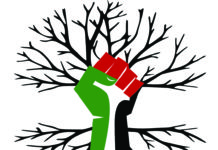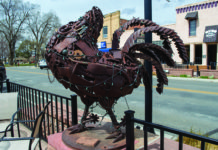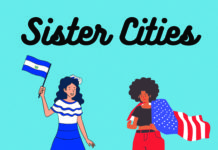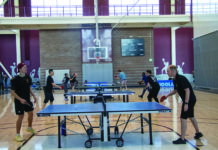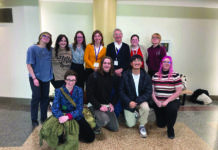To get into kindergarten, children have to be able to write their own name. A five-year-old boy from Grand Junction has a dream of doing just that. But, he doesn’t have his right hand. Being right-handed with the task of writing his name has been a challenge. Society of Women Engineers (SWE) at Colorado Mesa University has come to the rescue to give the boy a right hand.
The Colunga family has searched around Grand Junction for a prosthetic for their son, Rhyker. Rhyker was born with only up to his wrist on his right arm. With different prosthetics and expenses to consider they reached out to the SWE group for a chance that student engineers will take on a project.
Since August project leader Joseph Buches who is a senior at the University of Colorado and Colorado Mesa University mechanical engineer partnership program has taken on the task with five others to 3D print a prosthetic.
“First we met with them and figured out the dimensions of his arm and figured out if it [the prosthetic] had to be wrist actuate or elbow actuated,” Buches said. “Basically seeing if he has enough of his hand left that he can move his writ enough to lock a grip. Right now the only technology we have for the 3D printer ones the only way for the hand to actually grip is by flexing the wrist or elbow. We found that he doesn’t have enough hand to do a wrist actuated one so we will have to do an elbow one.”
The group will be making this prosthetic with heat formable plastic. Buches explained how they will print out all the different pieces and then some of them will form around his hand and some of it will already be formed.
“A lot of it will form to him since it is a custom prosthetic,” Buches said.
The group is working with the Innovation Center on CMU’s campus to use their printers. This also has decreased the cost for the Colunga family since the students are volunteering their time and the only real cost will be of the plastic for the printers. Another benefit is that someone in the SWE club will continue with the family.
“Someone in the club will continue it,” Buches said. “One of their [the Colunga’s] problems was that with a more expensive prosthetic you have to buy a new one every time he grows. Since he’s five they would need tons of them. That’s the beauty of 3D printing, he can come in and we have all the files and would just need some new measurements and then we can print another one.”
Buches explained how most of the math and critical thinking has come into play when deciding how they can adjust the prosthetic as Rhyker grows.
“Your palm doesn’t grow at the same rate as your fingers or as your arm, so we are figuring out all those dimensions for when he gets older,” Buches said.

The engineers had Rhyker come in to get a mold of his arm. They are able to use the mold to test everything for a general fit.
“From there we basically took a cast of his arm to get the dimensions and the next step is to 3D print a prototype and make sure it fits,” Buches said. “From there it will be meeting with the family doing trial and error, seeing what feels better and what we can do to fix it.”
There are many prosthetic designs out there Buches explained. It was hard to figure out the best design for Rhyker. They have decided that they will use fishing line to act as tendons and there will be a ratchet around the elbow that will move the fishing line when the elbow is flexed.
“Most of the research I have done is finding the right fit, there is a lot of people who have done similar things to this before so there are a lot of design out there that we can take and modify them,” Buches said. “I thought about designing one from scratch, but that would require way more knowledge.”
The goal is to make the prosthetic resemble closely to a real hand. They also have to make sure that this prosthetic can grip and hold a pencil.
“With prosthetics, it is pretty much impossible to write with a regular pencil grip, so we have looked into other ways to hold a pencil and other things,” Buche said.
There are two designs that the engineers are considering. One would have a hole in the palm of the prosthetic which would allow a pencil or something to screw into the hole. The other is some sort of attachment that could be added for a pencil or whatever else.
“We haven’t done a tone of work on it yet. The next step will be printing a prototype,” Buches said. “But with this, we are ready to start printing out, so hopefully we can get a prototype printed at the start of spring semester.”
Their goal deadline is to have a completed version that Rhyker loves by the end of the spring semester, yet getting it done earlier is what Buches is hopeful for.
“It’s been way different from any other project because there is usually one goal, and this is more about helping him,” Buches said.
“It has been way more rewarding, seeing his face when doing the mold, talking with him and showing him our design is just lit up. We have been doing little stuff with him and he loves superheros so we are going to try and do a superhero theme.”
The group has also turned to a man in town that works closely with veterans who have prosthetics. One of the biggest things will be comfortability. They plan on bringing the prototype to him to get his opinion on how to make it more comfortable. The group has yet to design or plan anything for that aspect since they have to make a prototype first.
“The more I do, the more interesting it gets,” Buches said.
Buches joined the SWE club this year and is the treasurer. He will be graduating in May and has an interest in Aerospace engineering, but has also discovered he is interested in prosthetics or engineering in the medical world.
This is his first project with the club, but there was a similar project last year that a group did for a child in China. Buches has reached out to that engineer for information and insight. He has had to do learn about prosthetics in general and some of the problems that come with them. The man in Grand Junction who works with the veterans has also been helpful in learning about prosthetics.
The SWE club has two projects that are using engineering to help someone who is disabled. Buches mentioned the next upcoming project the “Go Baby Go” that will take up most of the spring semester.
“There will be six different kids that have different disabilities,” Buches said. “We will make cars for them and then take them out and get them moving and giving them something to focus on.”
Buches says that this upcoming project will be open to the whole campus and they want anyone who is interested to get involved. He explained how people do not need engineering knowledge and all they want is interest.
Buches and whomever from the group that is staying near campus over winter break will continue to work on the prototype and then the adjustments and tweaks to their design will begin.

